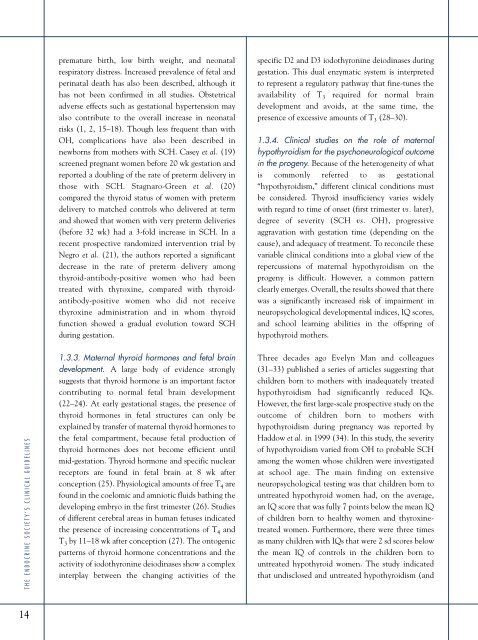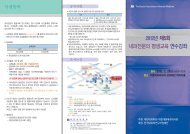Management of thyroid dysfunction during pregnancy and postpartum
Management of thyroid dysfunction during pregnancy and postpartum
Management of thyroid dysfunction during pregnancy and postpartum
You also want an ePaper? Increase the reach of your titles
YUMPU automatically turns print PDFs into web optimized ePapers that Google loves.
premature birth, low birth weight, <strong>and</strong> neonatal<br />
respiratory distress. Increased prevalence <strong>of</strong> fetal <strong>and</strong><br />
perinatal death has also been described, although it<br />
has not been confirmed in all studies. Obstetrical<br />
adverse effects such as gestational hypertension may<br />
also contribute to the overall increase in neonatal<br />
risks (1, 2, 15–18). Though less frequent than with<br />
OH, complications have also been described in<br />
newborns from mothers with SCH. Casey et al. (19)<br />
screened pregnant women before 20 wk gestation <strong>and</strong><br />
reported a doubling <strong>of</strong> the rate <strong>of</strong> preterm delivery in<br />
those with SCH. Stagnaro-Green et al. (20)<br />
compared the <strong>thyroid</strong> status <strong>of</strong> women with preterm<br />
delivery to matched controls who delivered at term<br />
<strong>and</strong> showed that women with very preterm deliveries<br />
(before 32 wk) had a 3-fold increase in SCH. In a<br />
recent prospective r<strong>and</strong>omized intervention trial by<br />
Negro et al. (21), the authors reported a significant<br />
decrease in the rate <strong>of</strong> preterm delivery among<br />
<strong>thyroid</strong>-antibody-positive women who had been<br />
treated with thyroxine, compared with <strong>thyroid</strong>antibody-positive<br />
women who did not receive<br />
thyroxine administration <strong>and</strong> in whom <strong>thyroid</strong><br />
function showed a gradual evolution toward SCH<br />
<strong>during</strong> gestation.<br />
specific D2 <strong>and</strong> D3 iodothyronine deiodinases <strong>during</strong><br />
gestation. This dual enzymatic system is interpreted<br />
to represent a regulatory pathway that fine-tunes the<br />
availability <strong>of</strong> T 3 required for normal brain<br />
development <strong>and</strong> avoids, at the same time, the<br />
presence <strong>of</strong> excessive amounts <strong>of</strong> T 3 (28–30).<br />
1.3.4. Clinical studies on the role <strong>of</strong> maternal<br />
hypo<strong>thyroid</strong>ism for the psychoneurological outcome<br />
in the progeny. Because <strong>of</strong> the heterogeneity <strong>of</strong> what<br />
is commonly referred to as gestational<br />
“hypo<strong>thyroid</strong>ism,” different clinical conditions must<br />
be considered. Thyroid insufficiency varies widely<br />
with regard to time <strong>of</strong> onset (first trimester vs. later),<br />
degree <strong>of</strong> severity (SCH vs. OH), progressive<br />
aggravation with gestation time (depending on the<br />
cause), <strong>and</strong> adequacy <strong>of</strong> treatment. To reconcile these<br />
variable clinical conditions into a global view <strong>of</strong> the<br />
repercussions <strong>of</strong> maternal hypo<strong>thyroid</strong>ism on the<br />
progeny is difficult. However, a common pattern<br />
clearly emerges. Overall, the results showed that there<br />
was a significantly increased risk <strong>of</strong> impairment in<br />
neuropsychological developmental indices, IQ scores,<br />
<strong>and</strong> school learning abilities in the <strong>of</strong>fspring <strong>of</strong><br />
hypo<strong>thyroid</strong> mothers.<br />
THE ENDOCRINE SOCIETY’S CLINICAL GUIDELINES<br />
1.3.3. Maternal <strong>thyroid</strong> hormones <strong>and</strong> fetal brain<br />
development. A large body <strong>of</strong> evidence strongly<br />
suggests that <strong>thyroid</strong> hormone is an important factor<br />
contributing to normal fetal brain development<br />
(22–24). At early gestational stages, the presence <strong>of</strong><br />
<strong>thyroid</strong> hormones in fetal structures can only be<br />
explained by transfer <strong>of</strong> maternal <strong>thyroid</strong> hormones to<br />
the fetal compartment, because fetal production <strong>of</strong><br />
<strong>thyroid</strong> hormones does not become efficient until<br />
mid-gestation. Thyroid hormone <strong>and</strong> specific nuclear<br />
receptors are found in fetal brain at 8 wk after<br />
conception (25). Physiological amounts <strong>of</strong> free T 4 are<br />
found in the coelomic <strong>and</strong> amniotic fluids bathing the<br />
developing embryo in the first trimester (26). Studies<br />
<strong>of</strong> different cerebral areas in human fetuses indicated<br />
the presence <strong>of</strong> increasing concentrations <strong>of</strong> T 4 <strong>and</strong><br />
T 3 by 11–18 wk after conception (27). The ontogenic<br />
patterns <strong>of</strong> <strong>thyroid</strong> hormone concentrations <strong>and</strong> the<br />
activity <strong>of</strong> iodothyronine deiodinases show a complex<br />
interplay between the changing activities <strong>of</strong> the<br />
Three decades ago Evelyn Man <strong>and</strong> colleagues<br />
(31–33) published a series <strong>of</strong> articles suggesting that<br />
children born to mothers with inadequately treated<br />
hypo<strong>thyroid</strong>ism had significantly reduced IQs.<br />
However, the first large-scale prospective study on the<br />
outcome <strong>of</strong> children born to mothers with<br />
hypo<strong>thyroid</strong>ism <strong>during</strong> <strong>pregnancy</strong> was reported by<br />
Haddow et al. in 1999 (34). In this study, the severity<br />
<strong>of</strong> hypo<strong>thyroid</strong>ism varied from OH to probable SCH<br />
among the women whose children were investigated<br />
at school age. The main finding on extensive<br />
neuropsychological testing was that children born to<br />
untreated hypo<strong>thyroid</strong> women had, on the average,<br />
an IQ score that was fully 7 points below the mean IQ<br />
<strong>of</strong> children born to healthy women <strong>and</strong> thyroxinetreated<br />
women. Furthermore, there were three times<br />
as many children with IQs that were 2 sd scores below<br />
the mean IQ <strong>of</strong> controls in the children born to<br />
untreated hypo<strong>thyroid</strong> women. The study indicated<br />
that undisclosed <strong>and</strong> untreated hypo<strong>thyroid</strong>ism (<strong>and</strong><br />
14

















